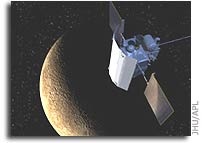MESSENGER Completes Forty Percent of Cruise Phase

On March 28, MESSENGER completed 40% of its five-year cruise phase, as measured by travel time. The probe has completed one-third of its flight distance on its trip to Mercury, and its average cruise speed will continue to increase as it homes in on its ultimate target: Mercury, the closest planet to the Sun. MESSENGER’s average speed will top out at a spacecraft record of close to 63 kilometers per second (141,000 miles per hour) in mid-October 2008. The cruise phase has been used to commission the spacecraft systems and instruments, as well as to fine tune the mission operations procedures of the team at the Johns Hopkins University Applied Physics Lab to ensure that the spacecraft and its instruments perform flawlessly at Mercury.
“The word ‘cruise’ can be misleading, because the time since launch has been quite busy and technically challenging,” says APL’s Andy Calloway, MESSENGER’s mission operations manager. “In the first 2.5 years of the mission, we have had a complete system and instrument commissioning,
propulsive trajectory correction maneuvers, two planetary flybys, a major processor software load, five instrument software loads, a long-duration solar conjunction period, numerous autonomy system loads, not to mention the anomalies that accompany any mission, such as an unexpected processor reset.”
An Earth flyby one year after launch and a large propulsive maneuver in December 2005 set the spacecraft on course for the first Venus flyby in October 2006. The Mercury Dual Imaging System (MDIS) acquired spectacular images of the Earth during the flyby, available at http://ser.sese.asu.edu/MESSENGER_20050802/close.html; as well as a “film” of Earth as it receded in the distance http://ser.sese.asu.edu/MESSENGER_20050802/list_movie_01.html, on the Web at http://ser.sese.asu.edu/MESSENGER_20050802/list_movie_01.html .
Planning is now underway to use the second Venus flyby on June 5 to complete final rehearsals for three Mercury flybys. Those flybys, assisted by four deep space maneuvers, will slow the spacecraft sufficiently for Mercury orbit injection on March 18, 2011. The upcoming planetary encounter also offers a variety of opportunities for making new observations of Venus’ atmosphere and cloud structure, space environment, and, perhaps even the surface. All of the MESSENGER instruments will be trained on Venus during the encounter.
- The MDIS will image the night side in near-infrared bands, and color and higher-resolution monochrome mosaics will be made of both the approaching and departing hemispheres.
- The UltraViolet and Visible Spectrometer, part of the probe’s Mercury Atmospheric and Surface Composition Spectrometer (MASCS), will capture profiles of emissions from atmospheric species versusaltitude on both the day and night sides as well as observations of the exospheric tail on departure.
- MASCS’s Visible and InfraRed Spectrograph will observe the planet near closest approach to assess the chemical composition of clouds. It may also detect near-infrared returns from the surface.
- The MESSENGER Laser Altimeter (MLA) will measure Venus’ brightness at 1064-nm by using its pulse return detector as a passive sensor. MLA will also pulse its laser in an attempt to measure the range to one or more cloud decks for several minutes near closest approach.
- The Magnetometer will characterize the magnetic structure of the Venus bow shock and draping of the interplanetary magnetic field over Venus’ ionosphere while the Energetic Particle and Plasma Spectrometer will observe charged particle acceleration and plasma flows associated with the bow shock.
The Venus Express mission of the European Space Agency is currently operating in an elliptical polar orbit about Venus, and MESSENGER’s June planetary encounter together with the ongoing observations by Venus Express will permit unique observations of the Venus-solar wind interaction. To understand fully how the solar wind plasma affects and controls the Venus ionosphere and nearby plasma dynamics, simultaneous measurements are needed of the interplanetary conditions and the particle-and-field environment at Venus. The combined MESSENGER and Venus Express observations will be the first opportunity to conduct such two-spacecraft measurements.
The Mercury flybys, in January and October 2008 and September 2009, will be used to provide initial maps of the hemisphere of the planet never before seen by spacecraft, as well as the first mineralogical data on Mercury’s surface. Calloway says the remaining sixty percent of the cruise phase will be equally challenging, “But even more rewarding because now we will be collecting information at Mercury that no one has ever seen before.”
A PLANETARY GEOLOGIST KEEPS HER EYE ON THE PLANETS
As the lead instrument scientist for MESSENGER’s Mercury Dual Imaging System (MDIS), Louise Prockter is all set to train her keen eye on images of Venus during the spacecraft’s second flyby of that planet in June that will send it onward to Mercury. But in her early years, studying the surface of planets was the farthest thing from her mind. Find out how she got her start in geophysics in her profile, online at http://messenger.jhuapl.edu/who_we_are/member_focus.html.
STAT CORNER
Now 972 days after launch, MESSENGER is about 53.4 million miles (86.7 million kilometers) from the Sun and 135.3 million miles (217.7 kilometers) from Earth. At that distance, a signal from Earth reaches the spacecraft in 12 minutes and six seconds. The spacecraft is moving around the Sun at 95,841 miles (154,241 kilometers) per hour. MESSENGER’s onboard computers have executed 255,719 commands from mission operators since launch on August 3, 2004.
MESSENGER (MErcury Surface, Space ENvironment, GEochemistry, and Ranging) is a NASA-sponsored scientific investigation of the planet Mercury and the first space mission designed to orbit the planet closest to the Sun. The MESSENGER spacecraft launched on August 3, 2004, and after flybys of Earth, Venus, and Mercury will start a yearlong study of its target planet in March 2011. Dr. Sean C. Solomon, of the Carnegie Institution of Washington, leads the mission as principal investigator. The Johns Hopkins University Applied Physics Laboratory built and operates the MESSENGER spacecraft and manages this Discovery-class mission for NASA.








